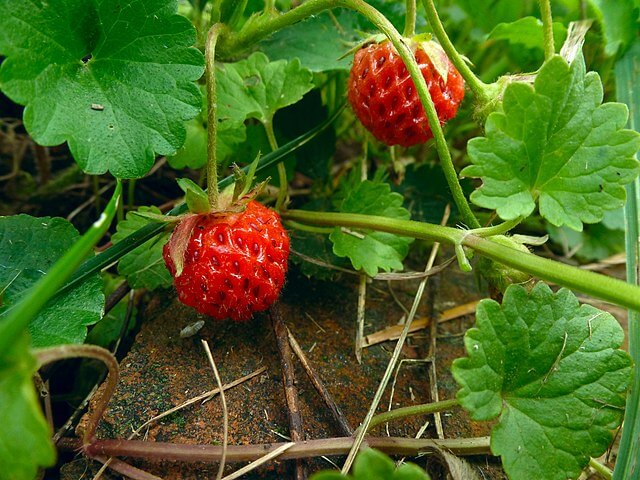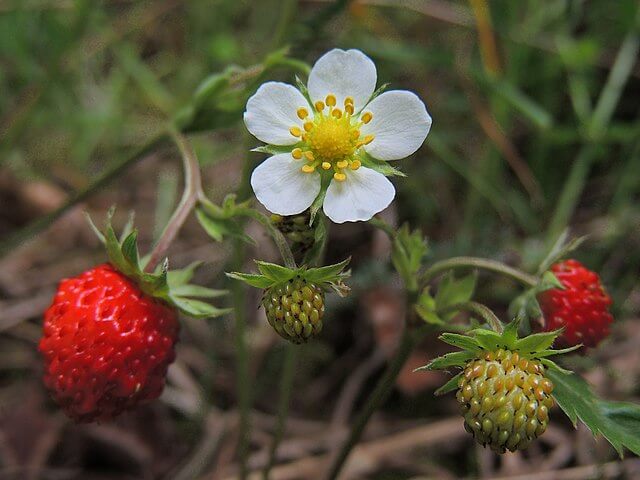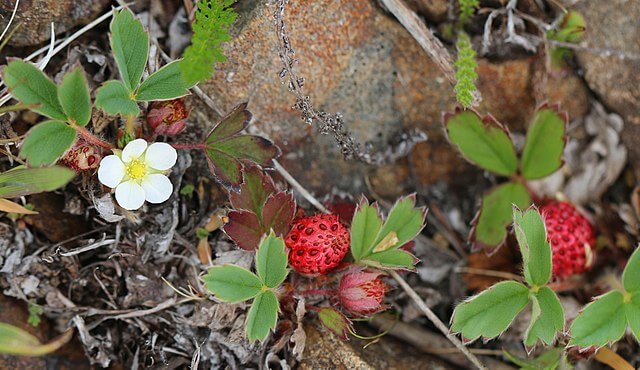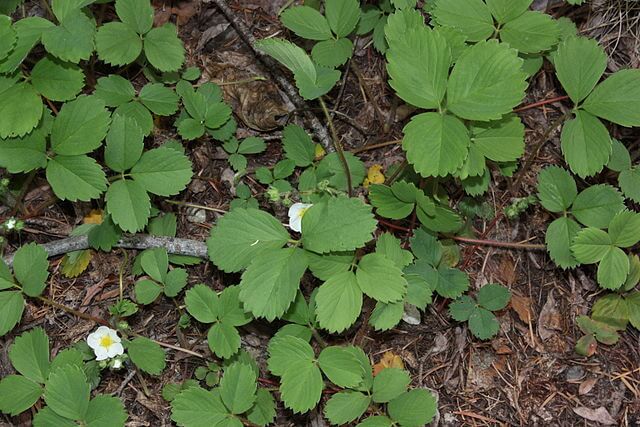A real treat to discover whilst out exploring the wilderness or hiking woodland trails, wild strawberries (Fragaria) can be found throughout the Northern Hemisphere. With around 20 different species naturalized to different countries and continents.
The two most common strawberry species within the US are the Virginia Strawberry (Fragaria virginiana) and the Woodland (European) Strawberry (Fragaria vesca).

The Differences Between American and European Wild Strawberries
Whilst out foraging in American forests or woodland it may not be immediately obvious which strawberry species you have stumbled across.
All wild strawberries have small white flowers, with a yellow center, and bear small, succulent, round red fruits. Each has the familiar strawberry sweetness we would expect from the cultivated Garden strawberry (Fragaria × ananassa). Each species also propagates via long trailing runners which reach out to new patches of soil to establish new plants.

The European Woodland strawberry plant is a little less refined. With tougher, more wrinkled leaves, and the small yellow ‘seeds’ protruding from the flesh instead of sitting within dimples like the Virginia strawberry fruit. The Virginia strawberry also supposedly has a sweeter flavoring, but both have a great strawberry flavor.
Other Strawberry Species in the US
There are also a number of lesser known strawberry species and hybrid crosses that you may stumble across in certain states. The Cascade strawberry (Fragaria cascadensis) can be found in the western Cascade Mountains that trail downwards from British Columbia all the way down to Northern California.
The Beach, or Chilean, strawberry (Fragaria chiloensis) which was one of the original species used to create the popular Garden strawberry is also endemic to the US. You might stumble across this species in coastal areas of California and even Hawaii.
There are a number of hybridized varieties too such as Fragaria × bringhurstii, as species cross pollinate with one another.

From The Wild, To The Garden
Strawberry cultivation in Europe began in the 14th century where it is believed the wild Woodland strawberry was grown in gardens and cultivated on a small scale. As explorers, and soon, colonists arrived in America, the Virginia strawberry was discovered. Like many other American plants, such as the wild grape (which infamously caused major disruption in many European vineyards), wild American strawberries were taken back to Europe for identification and study.
Creating the Common Garden Strawberry
Another major difference between the European and American strawberry species, is their cultivation histories. The American strawberry was selected as an optimal species to hybridize and create the now popular modern Garden strawberries that we enjoy today. Large and juicy, the Garden strawberry is a hybrid that was initially bred in France in the 1700s, using a combination of the Beach and Virginia Strawberry.
Wild Strawberries in Native American Cultures
The wild strawberries species of America were foraged and harvested by many Native American Nations. The leaves, runners and roots were also used frequently in medicinal applications and treatments. The Navajo Tribe in particular considered strawberries to be an important medicinal source.

The wild strawberry also held a symbolic importance for many different indigenous peoples. There is a famous Cherokee legend of the First Strawberry and strawberries are also featured within the Creation Stories of the Potawatomi People. Strawberry shaped baskets were created to show the significance of the fruit within the Potawatomi culture.
Foraging For Wild Strawberries and Cautions to Consider
Wild strawberries are a brilliant fruit to forage, but there is a strawberry lookalike to be cautious of when out foraging. As with any wild fruit, correct identification is extremely important, and it’s also important to never over-harvest, making sure to leave fruits behind for wildlife.
Did You Know…
Strawberries are not actually considered real berries, but instead they are known as ‘receptacles’ (a slightly less appetizing name!). The little yellow, seed-like pods on the outside of the strawberry flesh are also known as ‘achenes’, as technically, the seeds are found inside them!
The Origin of The Strawberry Name
Many conclude the name strawberry relates to the straw that was placed under the fruits to protect them from slugs and other pests. Some believe it relates to the fact they would be found at the edges of hayfields or woodland edges with wild grasses. However as with much colloquial naming, the history is not always definitive.

Wild strawberries have a rich and interesting history. Make sure to look out for wild strawberries on your next adventure into the wild. And possibly even consider growing some true native American strawberries at home, for your own personal supply of these sweet, summer treats.
—————Written by Hannah Sweet
Hannah is a freelance writer and graphic designer from the UK. With a penchant for travelling, photography and all things botanical, she enjoys writing about a wealth of topics and issues, from conservation and slow living, to design and travel. Learn more about her writing and design services at www.sweetmeanders.co
Many of our readers find that subscribing to Eat The Planet is the best way to make sure they don't miss any of our valuable information about wild edibles.
See our privacy policy for more information about ads on this site






